Once a year, wine loses all sensuality - at least for me - namely when the statistical office publishes its figures, comparisons, tables and cross-tabulations on wine. Then even my good bottle becomes a purely statistical quantity, a tiny proportion of the 273 million litres of wine drunk in Switzerland every year; statistically, therefore, my bottle is negligible. I myself (as a wine drinker) mutate into an anonymous consumer who drinks (on average) 353 glasses of wine a year. In moments like this, I regret not having counted all the glasses I have drunk, then at least I would now know whether I am an average, an above-average or even a below-average wine consumer. I suppose in this particular case I am above average. Tonight alone, now that I'm writing this column, it will probably be two or three glasses. In a year I write about 25 columns, so that makes 75 glasses, which means that almost a quarter of my statistical wine credit has already been used up, because the Swiss (and of course the Swiss woman) drink an average of 34 litres a year - statistically.
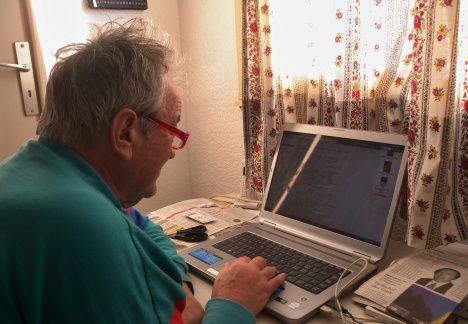 |
| Dishevelled hair while writing this column (Photo: P. Züllig) |
I have often wondered what such figures bring me. Information, of course. But is it useful for the wine drinker? Admittedly, the figures are - amidst all the praise in advertising, with all the superlatives - pleasantly factual, refreshing and above all neutral. For example, I now know - documented in black and white and also by the Federal Office for Agriculture - that I drink (on average) 34 litres of wine, more than a third of which (statistically) comes from Switzerland. I've always known - I've been told often enough - that we Swiss drink our own wines. But for me it's quite different. That's where my next concern comes in: am I really such a bad patriot? If I roughly survey my consumption of Swiss wines, it's not 30 per cent, at most five, maybe only three.
The very next statistical survey shakes my self-image again: the largest share of red wine imports (I'm an outspoken red wine drinker) comes from Italy, which is a good third more than from France. Oops! The proportion of wines from Italy that end up in my glasses is less than five per cent. Yet the Italians have risen unbelievably in my goodwill - wine-wise - in recent years. That, too, is - unfortunately - statistically insignificant.
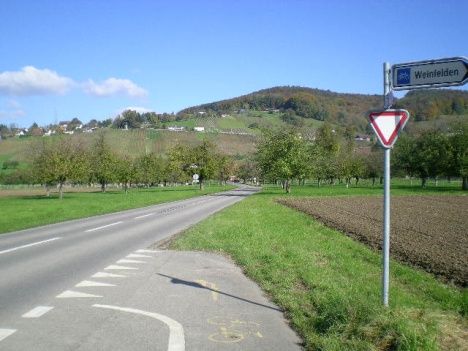 |
| The most famous vineyard in the canton of Thurgau: the Schlossgut Bachtobel in Weinfelden (Photo: P. Züllig) |
But it gets far worse! In the canton of Thurgau (eastern Switzerland, 254,000 inhabitants, just under 1,000 square kilometres), where almost 15,000 hectolitres of wine were produced last year, there has been a striking drop in sales, as much as 7.5 per cent. And I have contributed nothing to the turnaround with my three bottles (last year) from Thurgau - that is much less than one percent. My consolation: that is a fact, but statistically negligible. So I am comforted, because I could not have done that to my late father, who was a Thurgau native. But then there is a ray of hope in the sea of figures: more Swiss wine was drunk again (in percentage terms), almost ten million litres more, and at the expense of foreign wines. Here, too, I went against the trend. My wine consumption (I didn't drink all the wines myself, my wife and many guests were just as involved) consisted of a good ninety percent foreign wines, especially from the French.
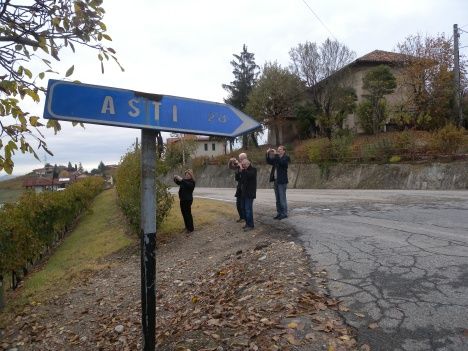 |
| Bold steps to Italy% to Piedmont (Photo: P. Züllig) |
Once again I am caught in the statistics trap. By far the most wines - according to the Federal Office - came from Italy, about 200,000 hectolitres more than from France. Again, I contributed nothing, but nothing at all, I could not save the French and their wines with my good 60 percent share of the wines drunk. Unfortunately, this is also statistically irrelevant. Let's stay in Switzerland for a moment. Switzerland consists of 26 cantons (depending on how you count them, because there are also "half-cantons"). Wine is made in not quite all of them (but almost all). Although it has long since ceased to be a central economic factor, rather a peripheral area in Switzerland's economic engine, winegrowing is still very important economically for some cantons. For example, in the mountainous canton of Valais, where by far the most vines are cultivated and from where therefore also the most Swiss wines come, about 165 thousand hectolitres per year. In the meantime, Valais wines have become something like ambassadors of Swiss wine, especially the autochthonous varieties, which have started a triumphant march through the wine world: Cornalin, for example, or Humagne Rouge, Amigne, Eyholzer, Heida, Himbertscha or even Lafnetscha. They may be exotic among the Valaisans, but they are talked about - and rightly so. And here's another statistical hammer blow: despite their fame, the autochthones make up only a very small part - less than three per cent - of the approximately 23,000( )! Valais winegrowers (about 20 percent of whom are full-time winegrowers).
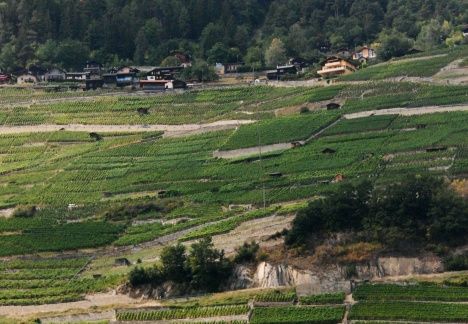 |
| Typical small-scale wine region in the Valais (Photo: P. Züllig) |
These rare grape varieties, of all things, also account for a considerable proportion of my Swiss wine consumption: without a statistical survey, I can say that it is certainly more than 30 per cent. On the other hand, I drink only a few bottles of Fendants - the best-known white wine from Valais (Chasselas grape) - and of the no less well-known red Dôle (Pinot Noir and Gamay) each year, and usually only when I have foreign guests who want to get to know Swiss wine. The more I dabble in the statistical figures, the weirder it gets. I'm obviously not a statistically relevant figure, I'm just a wine drinker - no, wine connoisseur, predominantly of red wines. At least there - that's a small ray of hope - I'm statistically on the right side. Significantly more red wine is drunk (or even stored, how can the statistical office know that so precisely?), namely 1,830,056 hectolitres of red wine compared to 1,084,953 hl of white wine (including sparkling wines).
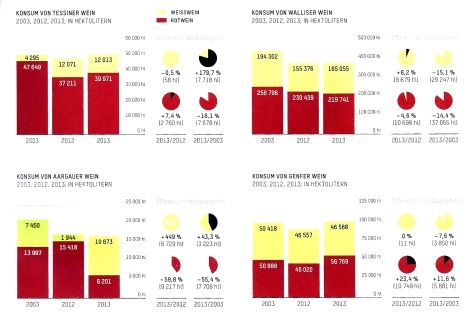 |
| Wine statistics - excerpt from the Swiss Wine Newspaper (Photo: P. Züllig) |
I am conciliatory, turn away from the official statistics again, preferring to focus on my wine in the glass: a French wine, of course - Château Beau-Séjour-Bécot 2000; slightly smoky, blackcurrants, cherries, liquorice, lovage, full-bodied and harmonious, a modern Bordeaux that I find incredibly enjoyable. Quickly forgotten are the statistics figures, forgotten until next year when the new values are published by the Federal Office for Agriculture. Then the next trip through the figures will be due, and it won't be much different from this year. But there is one thing I would like to know now: How do we stand in terms of wine consumption, internationally speaking? That's not in the federal statistics, but it's easy to find out (thanks to the internet). France is in the lead with 53 litres per capita, far behind is China with barely one litre. Switzerland ranks fourth, ahead of Germany (25 litres per capita). Suddenly it crosses my mind: What does it mean if China increases its wine consumption by one hundred per cent to two litres per capita? It's hard to imagine, because that means (with a population of 1.4 billion people) no less than 2.8 billion litres or 2.8 million hectolitres. Estimated world production of wine today: 250 million hectolitres, so the Chinese would (statistically) already drink away one hundredth of the world's wines, and with a consumption of 35 litres per capita (as in Switzerland), that would be...
No, I don't like to calculate it. I prefer to turn back to my wine glass. The wine calms me down and lets me sleep well - despite the statistics. Cheers!
Sincerely
Yours sincerely